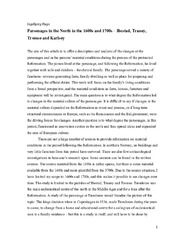Parsonages in the North in the 1600s and 1700s.
Forfatter
Hage, IngebjørgSammendrag
The aim of this article is to offer a description and analysis of the changes at the parsonages and in the parsons’ material conditions during the process of the protracted Reformation. The parson lived at the parsonage, and following the Reformation, he lived together with wife and children – the clerical family. The parsonage served a variety of functions: revenue-generating farm, family dwelling as well as place for preparing and performing the official duties. This work will focus on the family’s living conditions from a broad perspective, and the material conditions as farm, houses, furniture and equipment will be investigated. The main question is to what degree the Reformation led to changes in the material culture of the parsonages. It is difficult to say if changes in the material culture depended on the Reformation as event and process, or if long-term structural circumstances in Europe, such as the Renaissance and the Enlightenment, were the driving forces for changes. Another question is to what degree the parsonages, in this period, functioned as innovation centres in the north and thus spread ideas and expanded the area of European culture.
Forlag
De GruyterSitering
Hage I: Parsonages in the North in the 1600s and 1700s.. In: Berg SH, Bergesen RH, Kristiansen Rek. The Protracted Reformation in the North: Volume III from the Project “The Protracted Reformation in Northern Norway” , 2020. Walter de Gruyter p. 225-262Metadata
Vis full innførselSamlinger
Copyright 2020 The Author(s)


 English
English norsk
norsk